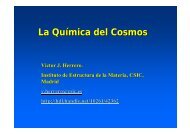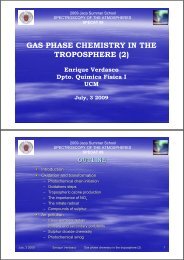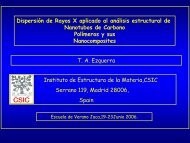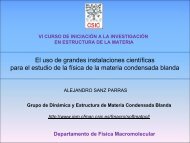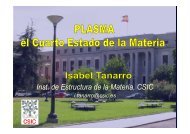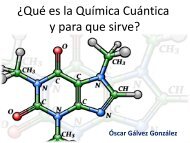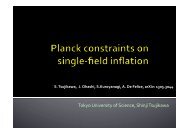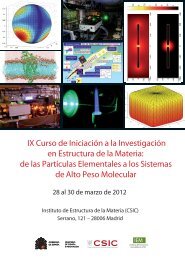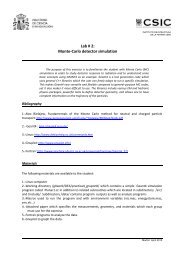terms and that b) stel<strong>la</strong>r pulsations of objects hovering right outsi<strong>de</strong> but extremely close to their gravitational radiuscan result in a mechanism for Hawking-like emission.ELECTRONIC PROPERTIES OF GRAPHENEDuring <strong>2011</strong>, we have investigated two different aspects of the electronicproperties of the carbon material, whichhave to do with the electronic confinement in graphene bi<strong>la</strong>yers and the dynamical generation of a gap by manybodyeffects in mono<strong>la</strong>yer graphene.We have studied the possibility of localizing electrons in graphene by means of synthetic gauge fields, created bythe mismatch in the <strong>la</strong>ttice registry of strained or twisted bi<strong>la</strong>yers. It is known that the most favorable regu<strong>la</strong>rstructure of graphene bi<strong>la</strong>yers corresponds to the so-called Bernal or AB stacking, in which the carbon atoms in asub<strong>la</strong>ttice of one of the <strong>la</strong>yers fall onto the atoms in the complementary sub<strong>la</strong>ttice of the other <strong>la</strong>yer. When the<strong>la</strong>ttices are distorted, either by strain, shear or twisting, the perfect registry is lost, and one observes the appearanceof typical Moiré patterns where regions of AB stacking alternate with others realizing AA stacking, in which thecarbon atoms in one of the <strong>la</strong>yers fall onto homologous atoms in the other <strong>la</strong>yer. We have shown that the alternationbetween the two types of stacking produces the same effect as having a non-Abelian SU(2) gauge potential, with theability of confining electrons in those regions of the bi<strong>la</strong>yer where the periodic effective field strength becomesmaximum.By applying uniaxial shear to one of the <strong>la</strong>yers, for instance, we can create a quasi-one-dimensional Moiré patternwith a perfect sequence of AA-AB-BA stacking along one of the directions of the bi<strong>la</strong>yer. In this case, the electronic<strong>de</strong>nsity can be confined into 1D channels corresponding to the regions with AA stacking, or AB-BA stacking,<strong>de</strong>pending on the longitudinal momentum of the electronic states. The band structure becomes strongly reminiscentof that found in thick carbon nanotubes in a real perpendicu<strong>la</strong>r magnetic field, where there is also a periodicmodu<strong>la</strong>tion of the flux around the section of the tube. The lowest-energy subband becomes extremely f<strong>la</strong>t for <strong>la</strong>rgeperiod of the stack modu<strong>la</strong>tion, corresponding to states localized in the regions of AB and BA stacking. Beyond acertain value of the longitudinal momentum, the electronic states start to disperse along branches linear in energy.This signals the <strong>de</strong>velopment of propagating mo<strong>de</strong>s along the one-dimensional channels with AA stacking, in closeanalogy with the behavior of the edge states in the quantum Hall effect of a 2D electron liquid in areal magneticfield.We have also applied our gauge field approach to un<strong>de</strong>rstand the electronic properties of twisted bi<strong>la</strong>yers, where there<strong>la</strong>tive rotation of one <strong>la</strong>yer with respect to the other induces a super<strong>la</strong>ttice with alternating regions of AA, AB andBA stacking. We have seen that the electron system <strong>de</strong>velops an extremely f<strong>la</strong>t lowest-energy subband for certainmagic values of the rotation angle, showing that this feature is a direct consequence of the presence of an effectivenon-Abelian SU(2) gauge field across the bi<strong>la</strong>yer. The <strong>la</strong>ck of dispersion is actually the signature of localized lowenergystates that are bound in this case around the regions of AA stacking, giving rise to a triangu<strong>la</strong>r array ofquantum dots. We have found that this pattern of confinement is consistent with the periodicity of the maxima in theeffective field strength, and that the first instance at which the lowest subband becomesf<strong>la</strong>t corresponds to the pointwhere the unit cell of the super<strong>la</strong>tticeis thread precisely by the quantum of gauge flux.The present approach supports in general the possibility of using the graphene bi<strong>la</strong>yers to realize non-AbelianAharonov-Bohm interferometry, by which the amplitu<strong>de</strong> of electrons injected into one of the <strong>la</strong>yers may oscil<strong>la</strong>teand even become completely transferred to the other <strong>la</strong>yer along their propagation. Furthermore, our study may alsoopen a new route to address the problemof localization of electronic states, which are not effectively constrained bysca<strong>la</strong>r potential barriers in graphene, but may be otherwise confined and manipu<strong>la</strong>ted in electronic <strong>de</strong>vices ma<strong>de</strong> ofgraphene bi<strong>la</strong>yers.On the other hand, we have continued the investigation of the dynamical generation of a gap in graphene, analyzingin particu<strong>la</strong>r the impact that theelectron self-energy corrections may have on the chiral symmetry breaking intheinteracting theory of Dirac fermions. Our starting point has been the <strong>la</strong>d<strong>de</strong>r approximation for the electron-holevertex appearing in the response function for dynamical gap generation, which we have improved byincludingsystematically the self-energy corrections to electron and hole states in the<strong>la</strong>d<strong>de</strong>r series.In this framework, we have been able to account for the effect of the Fermivelocity renormalization on the criticalcoupling for dynamical gap generation.In this respect, the growth of the Fermi velocity at low energies has beenalready observed in experiments carried out by the group of A. K. Geim with graphene at very low doping levels.Our results have shown actually that the effect of renormalization of the Fermi velocity induces a significantreductionin the strength of the dynamical symmetry breaking. We have found that the dynamical gap generationmay take p<strong>la</strong>ce above a critical value in the graphene fine structure constant α c ≈ 4.9, in the case of static RPA50
screening of the interaction potential in the <strong>la</strong>d<strong>de</strong>r series, and above a value α c ≈ 1.75 in the more sensible instanceof dynamical screening of the interaction.The main conclusion of our work is that the value α c ≈ 1.75, resulting from the most accurate treatment of the manybodycorrections, stillremains below the nominal value of the graphene fine structure constant in vacuum. Thismeans that an iso<strong>la</strong>ted free-standing <strong>la</strong>yer of the material should be in the phase with dynamical gap generation, inagreement with most part of less precise theoretical studies on the subject, but apparently at odds with presentexperimental measures in suspen<strong>de</strong>d graphene samples. A key observation is however that, if chiral symmetrybreaking is to proceed in graphene accordingto our estimates, it should lead to a gap at least three or<strong>de</strong>rs ofmagnitu<strong>de</strong>below the high-energy scale of the Dirac theory. This suggests then that thedynamical gap generationcannot be discar<strong>de</strong>d in iso<strong>la</strong>ted free-standing graphene, though its experimental signature may be only found insuitable samples, for which the Fermi level can be tuned within an energy range belowthe milli-electron-Volt scaleabout the charge neutrality point.EXACTLY SOLVABLE MODELSThe Richardson-Gaudin (RG) integrable pairing mo<strong>de</strong>ls emerged from the combination of the exact solution of theBCS Hamiltonian obtained by Richardson in the sixties and the integrable mo<strong>de</strong>l of quantum magnetism found byGaudin in the seventies. Formally, the RG mo<strong>de</strong>ls can be c<strong>la</strong>ssified two families, the rational family and thehyperbolic family. The rational family contains the BCS Hamiltonian as well as many other exactly solvableHamiltonians studied in the <strong>la</strong>st <strong>de</strong>ca<strong>de</strong> in the areas of nuclear structure, ultrasmall superconducting grains, quantumdots, trapped cold fermionic and bosonic gases, etc. In 2009 it has been shown that the px+ipy pairing Hamiltonian<strong>de</strong>scribing the interaction between spinless fermions in 2D <strong>la</strong>ttices, is exactly solvable and it pertains to hyperbolicfamily. This Hamiltonian, studied by Read in connection to the fractionary quantum Hall effect, has a phasediagram with a topological phase transition (without or<strong>de</strong>r parameter). From <strong>de</strong> exact solution we studied the phasediagram of for one channel Hamiltonians (pairing interaction). The mo<strong>de</strong>l disp<strong>la</strong>ys a quantum phase transition of 3ºor<strong>de</strong>r compatible with the <strong>la</strong>ck of an or<strong>de</strong>r parameter. The exact wave function of the RG mo<strong>de</strong>ls is a product ofcorre<strong>la</strong>ted pairs whose bound energies come from the solutions of the Richardson equations. The size of thecon<strong>de</strong>nsed wave function, which experimentally accessible in ultracold po<strong>la</strong>rized gases, disp<strong>la</strong>ys a divergence at thecritical point. Therefore, it can be used as an experimental signature. The structure of the Cooper pairs is moredifficult to be revealed experimentally. However, its size has been associated with threshold in energy of the radiofrequencyspectrum in trapped gases. The structure of p-wave pairs is different of the s-wave pairs. It shows anabrupt change between the weak pairing phase (exten<strong>de</strong>d pairs) and the strong pairing phase (bound pairs). Westudied the extension of the px+ipy mo<strong>de</strong>l to a two channel mo<strong>de</strong>l in which the interaction is mediated by a p-waveFeshbach resonance. The corresponding phase diagram also shows a 3º or<strong>de</strong>r quantum phase transition that wecharacterized by means of the quantum fi<strong>de</strong>lity. The analysis of this magnitu<strong>de</strong> led us to conclu<strong>de</strong> that the phasetransition cannot be <strong>de</strong>scribed by the Landau theory.The second realization of the hyperbolic family consists on an exactly solvable Hamiltonian with non-<strong>de</strong>generatesingle particle energies and a separable pairing interaction with two free parameters. One of the parameters is thestrength of the pairing interaction and the other is an energy cutoff. We showed that these parameters can beconveniently chosen to reproduce the physical properties of the ground state of heavy nuclei <strong>de</strong>scribed by the Gognyforce. In particu<strong>la</strong>r, we showed that the hyperbolic mo<strong>de</strong>l <strong>de</strong>scribes with great precision the wave function of theGogny Hartre-Fock-Bogoliubov approximation. We also showed that the Gogny gaps disp<strong>la</strong>y a behavior compatiblewith the square root in the form factors of the hyperbolic interaction. This new exactly solvable mo<strong>de</strong>l opens theway for the construction of a selfconsistent algorithm of Hartree-Fock plus exact pairing for the <strong>de</strong>scription ofmasses and low energy properties of heavy nuclei.QUANTUM TRANSPORTDuring 2010 we have focused our efforts in the study of the transmission phase through quantum dots in theCoulomb blocka<strong>de</strong> regime. Quantum mechanics fundamentally differs from c<strong>la</strong>ssical mechanics in that timeevolutions are <strong>de</strong>termined by complex probability amplitu<strong>de</strong>s instead of real probabilities. Theassociated phase is akey element to un<strong>de</strong>rstand mesoscopic transport experiments on Aharonov-Bohm (AB) conductance oscil<strong>la</strong>tions,weak localization, and conductance fluctuations. For a long time, the transmission amplitu<strong>de</strong> phase through aquantum dot could not be measured directly. The pioneering experiments of Yacoby et al. opened a new field inmesoscopic physics at the end of the 90s when they embed<strong>de</strong>d a quantum dot into one of the arms of an Aharanov-Bohm interferometer. However, these experiments have escaped a consistent and generic theoretical exp<strong>la</strong>nation.Specially surprising is the fact that a phase <strong>la</strong>pse of πalways appears between resonances in the transmission phasefor quantum dots with <strong>la</strong>rge number of electrons.51
- Page 3: INTRODUCCIÓNEl Instituto de Estruc
- Page 10 and 11: Dra. Maria Esperanza Cagiao Escohot
- Page 12 and 13: TALLER ÓPTICOD. José Lasvignes Pa
- Page 14 and 15: 2A.1 DPTO. DEQUÍMICA YFÍSICA TEÓ
- Page 16: empezar a caer. Este fenómeno se e
- Page 19 and 20: Existen varias diferencias entre la
- Page 21 and 22: Estudio de las propiedades estructu
- Page 23 and 24: poblar los estados de interés en 1
- Page 25 and 26: Si bien la técnica TF está bien e
- Page 27 and 28: que no se produzca la ruptura de en
- Page 30 and 31: antitumoral emodina mediante el efe
- Page 32 and 33: Esta formulación ha sido desarroll
- Page 34 and 35: oooooCriogenia.Espectroscopía Rama
- Page 36 and 37: FLUIDODINÁMICA MOLECULAREl princip
- Page 38 and 39: También se ha concluido y publicad
- Page 40 and 41: o Análisis mecánico en tracción:
- Page 42 and 43: cuerpo (BCC), tiene lugar la formac
- Page 44 and 45: BIOSAXSCaracterización de coloides
- Page 46 and 47: Sin embargo, desde el punto de vist
- Page 48 and 49: 2B.1 THEORETICAL PHYSICS AND CHEMIS
- Page 52 and 53: We have investigated transport thro
- Page 54 and 55: een proposed as possible interstell
- Page 56 and 57: The figure shows a compilation of t
- Page 58 and 59: oppositely aligned spins. This pair
- Page 60 and 61: PHYSICAL BEHAVIOR AT NANO-SCALESPro
- Page 62 and 63: done in collaboration with research
- Page 64 and 65: Finally, we have also conducted a w
- Page 66 and 67: species have been obtained from tim
- Page 68 and 69: Rideal mechanism, with a preference
- Page 70 and 71: Liquid hydrogen filament (5 micron
- Page 72 and 73: Nanostructure of polymer thin films
- Page 74 and 75: morphological model for Natural Rub
- Page 76 and 77: product. The clay can be used direc
- Page 78 and 79: with the extracellular ERBBs domain
- Page 80 and 81: 3.1 DPTO. DEQUÍMICA YFÍSICA TEÓR
- Page 82 and 83: Duration: January 2010-December 201
- Page 84 and 85: Objectives: This Project aims at ob
- Page 86 and 87: Funding Institution: Comunidad de M
- Page 89 and 90: CAPÍTULO 4COOPERACIÓN CIENTÍFICA
- Page 91 and 92: 4.1.3 DPTO. DE FÍSICA MOLECULAR /
- Page 93 and 94: o Complete Hybrid Quantization of a
- Page 95 and 96: R3B Collaboration Meeting, Darmstad
- Page 97 and 98: SERS Roundtable 2011, Poltersdorf (
- Page 99 and 100: International Conference on Process
- Page 101 and 102:
4.3. ESTANCIAS DE INVESTIGADORES EN
- Page 103 and 104:
Dr. Francesca Vidotto.Université d
- Page 105 and 106:
4.4.3 DPTO. DE FÍSICA MOLECULAR /
- Page 107:
Guillermo Ribeiro Jiménez. Subatom
- Page 110 and 111:
5.1 DOCENCIA / TEACHING5.1.1 DPTO.
- Page 112 and 113:
5.1.3 DPTO. DE FÍSICA MOLECULAR /
- Page 114 and 115:
5.2.3 DPTO. DE FÍSICA MOLECULAR /
- Page 116 and 117:
Óscar Gálvezo Hielos y Plasmas de
- Page 118 and 119:
Olof Tengblad- Deputy Technical Man
- Page 120 and 121:
5.5 ACTIVIDADES Y MATERIAL DE DIVUL
- Page 122 and 123:
Plasma, el cuarto estado de la mate
- Page 124 and 125:
5.7 UNIDADES ASOCIADAS Y OTRAS ACTI
- Page 126 and 127:
oScientific collaboration on “Din
- Page 128 and 129:
6.1 PUBLICACIONES EN REVISTAS Y PRO
- Page 130 and 131:
Prescriptions in Loop Quantum Cosmo
- Page 132 and 133:
Richardson-Gaudin Models: The Hyper
- Page 134 and 135:
79. L. Guerrini, S. Sanchez-Cortes,
- Page 136 and 137:
Probing the Nature of Particle-Core
- Page 138 and 139:
PROCEEDINGS ISI /ISI PROCEEDINGS120
- Page 140 and 141:
Physical Review Letters 106, 245301
- Page 142 and 143:
Conducting Nanocomposites Based on
- Page 144 and 145:
3. O. S. Kirsebom, S. Hyldegaard, M
- Page 146 and 147:
6.4 TESIS DOCTORALES / Ph. D. THESE
- Page 149 and 150:
CAPÍTULO 7TABLAS Y DATOSCHAPTER 7T
- Page 151 and 152:
Spectrochimica Acta B 2 3.552Chemph
- Page 153 and 154:
7.4 PERSONAL POR DEPARTAMENTOS /PER
- Page 155 and 156:
ÍNDICEINDEX155
- Page 157 and 158:
4.1.2 Dpto. de Espectroscopía Nucl
- Page 159:
6.2.2 Dpto. de Espectroscopía Nucl




